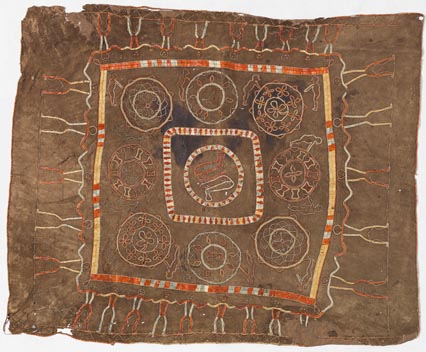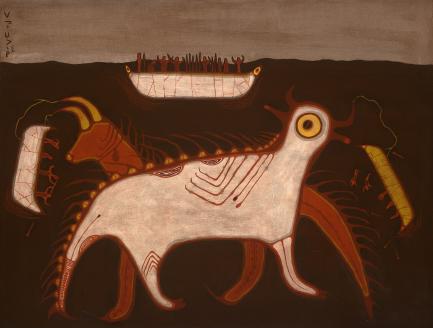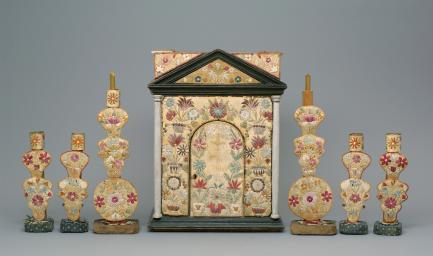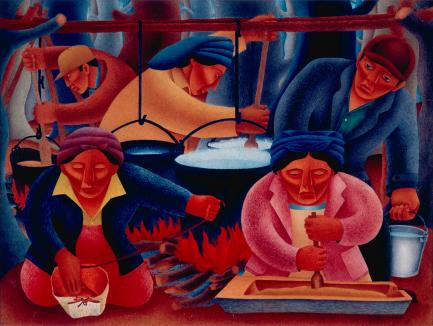“Before and after the Horizon: Anishinaabe Artists of the Great Lakes” Opens in New York Aug. 10
The Smithsonian’s National Museum of the American Indian and the Art Gallery of Ontario co-present “Before and after the Horizon: Anishinaabe Artists of the Great Lakes,” the first major museum survey of Native artists from the Great Lakes region. Curated by David Penney, associate director of research at the National Museum of the American Indian in Washington, and Gerald McMaster (Plains Cree/Siksika First Nation), the exhibition features more than 100 works from prehistory to the present day and will explore the ways many generations of Anishinaabe have expressed their relationships with their homeland. This important exhibition presents Anishinaabe stories, histories and experiences, providing visitors with dynamic indigenous perspectives from the peoples of the Ojibwe (Chippewa), Odawa (Ottawa) and Potawatomi nations.
“Before and after the Horizon” is divided into six concepts that have been important to Anishinaabe people: place, the traditional Anishinaabe home in the Great Lakes region; cosmos, traditional spirituality and the Anishinaabe conception of their place in the universe; church, Anishinaabe relations with Christianity; contested space, the Great Lakes region as a point of contact and engagement between Anishinaabe people and the outside world; cottager colonialism, Anishinaabe relations with early and ongoing vacation visitors to the Great Lakes region; and many worlds, the multiple cultural influences characteristic of the Anishinaabe experience today.
People have lived in the Great Lakes region for more than 10,000 years, even when its present terrain was forming in the wake of thousands of years of Ice Age glaciation. The first section of the exhibition is dedicated to the continuity of these communities and will detail the Anishinaabe relationship to Great Lakes natural features, places and resident beings. The exhibition then leads visitors to a section that examines the Great Lakes as a “contested space,” where the conflicting ideologies and objectives of the Anishinaabe and newcomers played out in treaties, political conflict, land cessions and consequent cultural marginalization.
The exhibition will showcase contemporary and modern works along with historic, ancestral objects. Among the modern artists are Norval Morrisseau, George Morrison, Blake Debassige and Daphne Odjig, who each in their own way sought visual expression for the spiritual and social dimensions of human relationships with the earth. These same sources of inspiration are visible in traditional Anishinaabe arts, such as doodem or clan pictographs on treaty documents, bags embroidered with porcupine quills, painted drums, carved pipes, spoons and bowls. The continuity of Anishinaabe art emphasizes traditional Anishinaabe spiritual perceptions, which are very much part of Anishinaabe identity today.
“Before and after the Horizon: Anishinaabe Artists of the Great Lakes” is accompanied by a fully illustrated publication featuring texts by contributors—David W. Penney, Alan Corbiere, Crystal Migwans, Ruth B. Phillips and Gerald McMaster—who will examine the ways in which the artists have depicted stories, histories and experiences of the Great Lakes. The authors also discuss how the artists, in their work, have accommodated, incorporated or challenged newcomers. Showcasing the powerful indigenous art of a region that spans national borders, this book provides readers with an understanding of the Anishinaabe as contemporary citizens of North America with deep roots in their Great Lakes homeland. The exhibition will be supported by public programming and community outreach initiatives.
The exhibition will be on view at the National Museum of the American Indian in New York from Saturday, Aug. 10, through June 2014. The museum is located in the historic U.S. Custom House at One Bowling Green in lower Manhattan. Following the presentation in New York, the exhibition will travel to the Art Gallery of Ontario, Toronto, in the heart of the Anishinaabe’s traditional territory. Toronto is home to a number of artists represented as well as numerous social and cultural organizations serving the Anishinaabe community and other First Nations.
The museum is free and open every day from 10 a.m. to 5 p.m., and on Thursdays until 8 p.m. (closed Dec. 25). Call (212) 514-3700 for general information and (212) 514-3888 for a recording about the museum’s public programs. By subway, the museum may be reached by the 1 to South Ferry, the 4 or 5 to Bowling Green or the R to Whitehall Street. The museum’s website is www.AmericanIndian.si.edu.
# # #
SI-290B-2013









